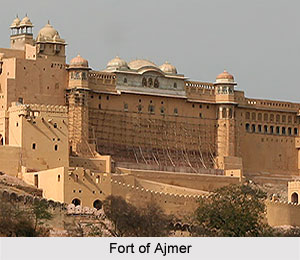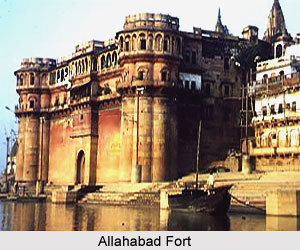 Mughal architecture is that redefining domain amidst the most darkness of Indian context, when India perhaps was almost falling into a phase of near-Dark Age in the domain of architectural prowess. Constant uprisings, incursions from the Afghanistan and Persian front was weakening the borderline areas of the country, which had begun to take its toil upon the then existing Islamic realm, the Delhi Sultanate. And it was during that perfectly timed moment that Babur had alighted unto India to rule for the next 200 and more years, with his Mughal Empire, beginning in 1526 A.D. Now, Mughal architecture in Ajmer is one area which was accomplished by the most cardinal and towering Mughals, continuing down well into the later Mughals, however with diminishing glory. However, by the time Mughal architecture had arrived onto Ajmer, it was already a time during which the Mughals had established their own supreme and prominent identity, which verily was rooted in the realm of `Indo-Islamic architecture in India`, a first of its kind under an `Islamic India`. And this precise background needs further enhancement, after which can only the Ajmeri architecture in India during the Mughals can be comprehended.
Mughal architecture is that redefining domain amidst the most darkness of Indian context, when India perhaps was almost falling into a phase of near-Dark Age in the domain of architectural prowess. Constant uprisings, incursions from the Afghanistan and Persian front was weakening the borderline areas of the country, which had begun to take its toil upon the then existing Islamic realm, the Delhi Sultanate. And it was during that perfectly timed moment that Babur had alighted unto India to rule for the next 200 and more years, with his Mughal Empire, beginning in 1526 A.D. Now, Mughal architecture in Ajmer is one area which was accomplished by the most cardinal and towering Mughals, continuing down well into the later Mughals, however with diminishing glory. However, by the time Mughal architecture had arrived onto Ajmer, it was already a time during which the Mughals had established their own supreme and prominent identity, which verily was rooted in the realm of `Indo-Islamic architecture in India`, a first of its kind under an `Islamic India`. And this precise background needs further enhancement, after which can only the Ajmeri architecture in India during the Mughals can be comprehended.
Emperor Akbar was that man who was capable of huge and immense possibilities within him in each matters of the Mughal Dynasty. During his period, India had witnessed a uniformity of rule and administration in matters pertaining to daily life. His architectural prowess was also an area which perhaps needs no introduction at such a phase now, what with structures conceived like the Fatehpur Sikri, several structures housed within the Agra Fort and edifices in Allahabad Fort.  Akbar`s fame had reached far and wide in relation to architecture which always were build in colossal and sky-kissing dimensions always; in fact, it was Akbar himself who first had realised to consolidate places as far off like Rajasthan, thus counting in the format of Ajmer and its importance in the Mughal Empire. Architecture in Ajmer during Akbar was on the foremost based potentially upon religious constructions, with the first grounding of renovation of the hallowed dargah of Muin ud-Din Chisthi. Emperor Akbar was legendary as a man who was born with a religious bent of mind, thus explaining his most ardent urge to re-fashion and refurbish the dargah of Chisthi. Mughal architecture in Ajmer was indeed truly benefitted under Akbar, with his other interests in the realm of building additional mosques pivoting around Muin ud-Din Chinsthi`s dargah. Indeed, under Akbar`s patronage, Ajmer`s Mughal architecture was taken to promising heights, which was only left back by this emperor to his son and heir, Jahangir, to capture the lofty imagination of religious significance.
Akbar`s fame had reached far and wide in relation to architecture which always were build in colossal and sky-kissing dimensions always; in fact, it was Akbar himself who first had realised to consolidate places as far off like Rajasthan, thus counting in the format of Ajmer and its importance in the Mughal Empire. Architecture in Ajmer during Akbar was on the foremost based potentially upon religious constructions, with the first grounding of renovation of the hallowed dargah of Muin ud-Din Chisthi. Emperor Akbar was legendary as a man who was born with a religious bent of mind, thus explaining his most ardent urge to re-fashion and refurbish the dargah of Chisthi. Mughal architecture in Ajmer was indeed truly benefitted under Akbar, with his other interests in the realm of building additional mosques pivoting around Muin ud-Din Chinsthi`s dargah. Indeed, under Akbar`s patronage, Ajmer`s Mughal architecture was taken to promising heights, which was only left back by this emperor to his son and heir, Jahangir, to capture the lofty imagination of religious significance.
Architecture in Ajmer during Jahangir was also very much followed in the lines of his father, beginning of course with pilgrimage made on foot to the shrine of Muin ud-Din Chisthi. Mughal architecture in Ajmer during Jahangir was primarily however possible owing to the emperor`s zealous and fervent pursuits of a Rana from Mewar and defeating him, and thus commemorating by visiting to the Chisthi dargah. However, Jahangir, being a man with an artistic and musical bent of mind, had constructed various pleasure pavilions and humble palaces in Ajmer by water bodies, one being the Pushkar lake. Mughal architecture in Ajmer under Jahangir`s hands in the religious realm was made in the form that he is known to have donated a gargantuan cauldron for the needy and the deprived, deriving nutrition from the place of the Almighty. Jahangir`s Mughal architecture by Ajmer, however, were more pronounced in those named pavilions and palaces which were meticulously conceived for future usage and further renovations were made by the heir-apparent, then still a prince, Shah Jahan.
 Emperor Shah Jahan of the Mughal Empire never does need any introduction, after his completion of the out-of-this-world creation of the Taj Mahal. Mughal architecture in Ajmer under Shah Jahan was just as enigmatic and fileld with aura, as if a reflection of the emperor himself. His substantial and praiseworthy additions to Jahangir`s palaces by the water tanks, in the form of Public Audience Hall and also an exquisite viewing balcony, are instances enough in present times to represent a subtle sense of respect and reverence. It was Shah Jahan who had also added a Jama Masjid to the Mughal architecture in Ajmer, at times verily compared and equated with the legendary Jama Masjid in Fatehpur Sikri, a creation of Akbar himself. Shah Jahan was quite meticulous and routined in his creations which would be accomplished, hence answering his matured interest night and day in the architectural completion in Ajmer, a Mughal doing and prestigious legacy since the times of Babur. As such, architecture in Ajmer during Shah Jahan was a masterpiece both by him and his sub-imperially partonaged noblemen and the likes. The dargah of Muin ud-Din Chisthi also was given a routined and systematic facelift in a smooth manner under this man for whom nothing was impossible.
Emperor Shah Jahan of the Mughal Empire never does need any introduction, after his completion of the out-of-this-world creation of the Taj Mahal. Mughal architecture in Ajmer under Shah Jahan was just as enigmatic and fileld with aura, as if a reflection of the emperor himself. His substantial and praiseworthy additions to Jahangir`s palaces by the water tanks, in the form of Public Audience Hall and also an exquisite viewing balcony, are instances enough in present times to represent a subtle sense of respect and reverence. It was Shah Jahan who had also added a Jama Masjid to the Mughal architecture in Ajmer, at times verily compared and equated with the legendary Jama Masjid in Fatehpur Sikri, a creation of Akbar himself. Shah Jahan was quite meticulous and routined in his creations which would be accomplished, hence answering his matured interest night and day in the architectural completion in Ajmer, a Mughal doing and prestigious legacy since the times of Babur. As such, architecture in Ajmer during Shah Jahan was a masterpiece both by him and his sub-imperially partonaged noblemen and the likes. The dargah of Muin ud-Din Chisthi also was given a routined and systematic facelift in a smooth manner under this man for whom nothing was impossible.
Architecture in Ajmer during Aurangzeb, however, witnessed a sudden and shocking downfall in the most superlative and unmatched domain of Mughal architecture in Ajmer or elsewhere. Indeed, Aurangzeb was such a man, who was much self-centred and as such never did pay attention towards the betterment of his dynasty or for that matter, his countrymen. Owing to his such self-absorbed and egotistical tendencies, Mughal architecture in Ajmer had suffered hugely, both in terms of religion as well in other phases of palaces or gardens - an element which was thoroughly taken up during his father Shah Jahan`s reign. Indeed, Aurangzeb`s times in a Mughal Ajmer and its architecture was a bit saved from suffering by his nobility and royally patronaged men, who had endeavoured to bring back some of the magic of the erstwhile brilliant Mughals. As such, Mughal architecture in Ajmer under Aurangzeb`s times was mostly restricted to building of tombs of marble, erected in memory of the nobility or their relations, at times bearing some semblance also to historic and legendary Mughal architectures like the Jama Masjid of Old Delhi or the one in Fatehpur Sikri. The dargah of Muin ud-Din Chisthi was also lost to unimportance during Aurangzeb.



















